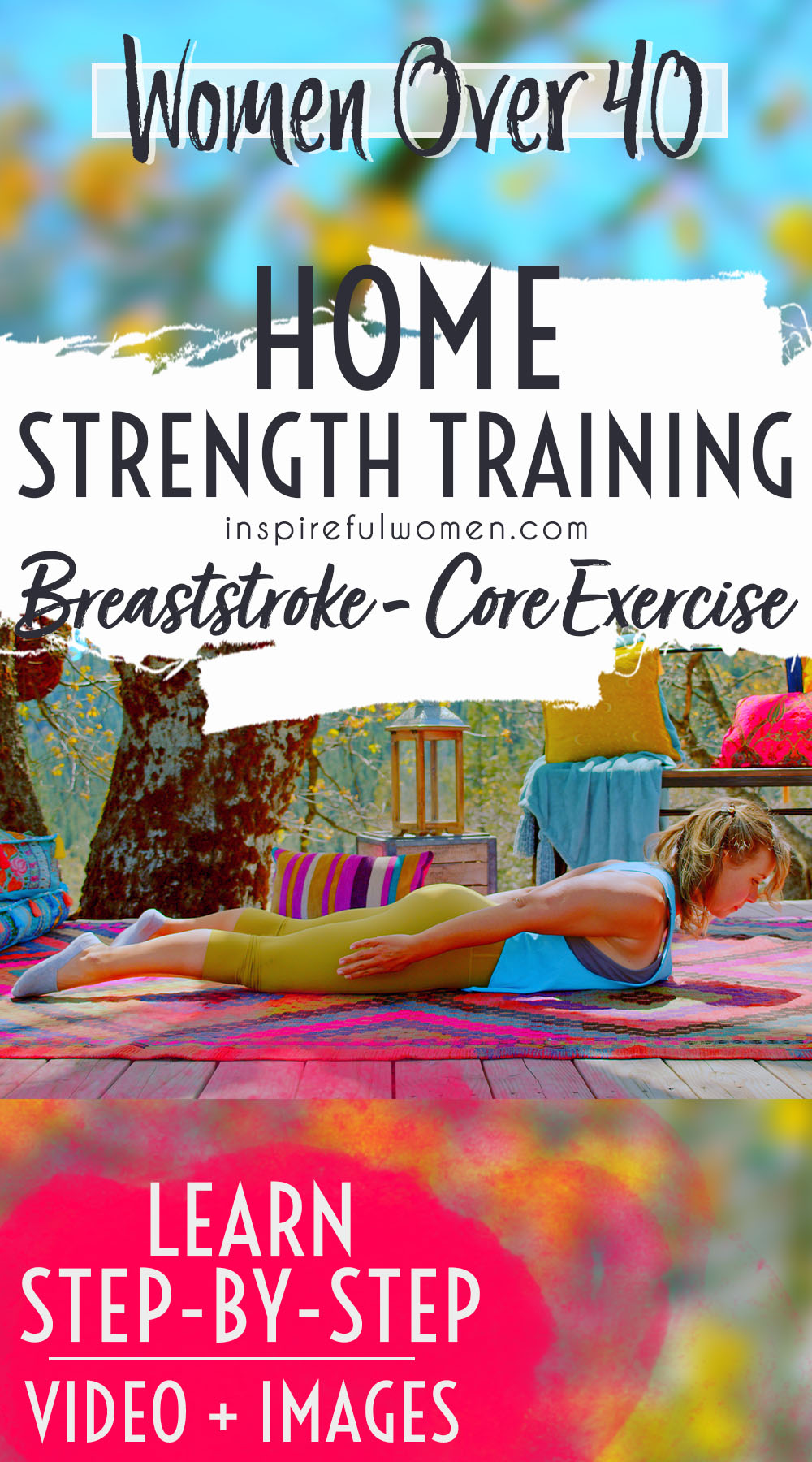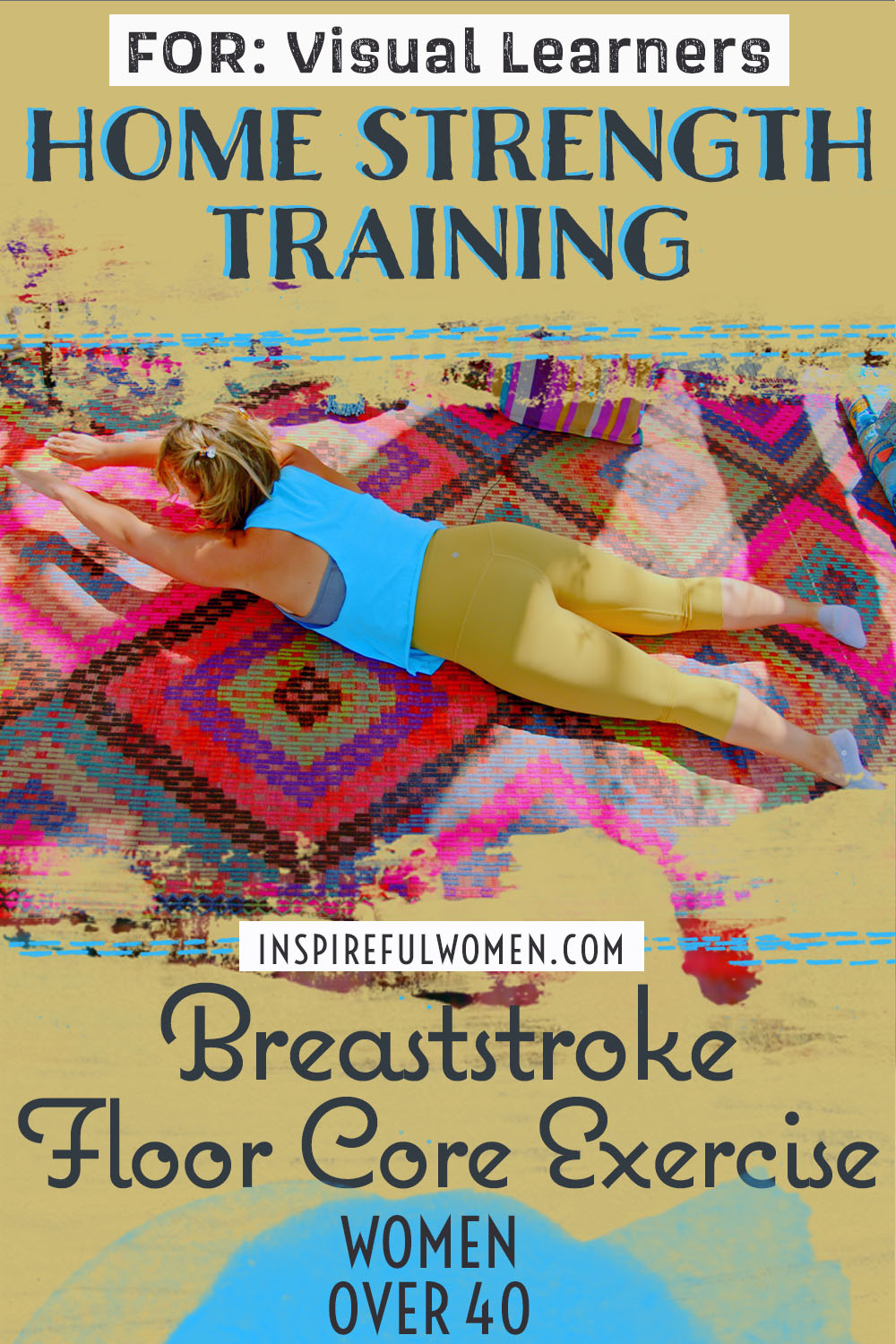Breaststroke - Core & upper back
How to Do the Breaststroke - Pilates Core & Upper Back Exercise | In-Depth Guide [VISUAL LEARNERS] Beginner
Proper Form, Common Mistakes & Easier Variations | Home Resistance Training
WHAT DO YOU WANT TO SEE?
QUICK DEMO
QUICK DEMO
MUSCLES THIS WORKS
MUSCLES
MAIN MUSCLES WORKED IN the Breaststroke
Thoracic erector spinae
OTHER MUSCLES WORKED:
- Transversus Abdominis
- Rectus Abdominis
- Deep Cervical Flexors (Longus Colli, Longus Capitis, Rectus Capitis, Longus Cervicis)
- Obliques
- Quadratus Lumborum
- Glute Max
- Multifidi
- Rhomboids
- Mid Trap
- Lower Trap
- Rear Deltoids
WHAT WE'RE DOING TODAY
WHAT & WHY
BENEFITS OF TRAINING THE CORE muscles
WHAT
WHAT WE'RE DOING TODAY
Other names for this exercise: Swimming
ALL WE'RE DOING:
This one is a little like swimming on your living room floor.
The breaststroke is such a GEM of a movement. It’s a special gem that I mistakenly thought was just a piece of dirt-encrusted broken glass. By that I mean I totally misjudged this move until I started doing it.
There are very few other exercises, especially home ones, where you can work your upper back muscles in this way and it’s harder than it. Looks! We’re going to strengthen our upper back and core with this move, we’re going to do it with only our bodyweight, and no equipment is needed (unless you get good, then you can add 2 very light dumbbells or cans of soup or something) AND we’re…..laying down. That always needs to be said twice. We’re doing this movement……laying down. :)-
This is a challenging and fun exercise that is great for improving posture. I put off learning this movement myself for quite a while because I was being a total snob about it - I didn’t think it looked all that interesting or useful, but as soon as I began doing it I was in love!
So, let’s go swimming in your living room, with no water.
WHY BOTHER DOING IT?
WHY
WHY DO WE EVEN CARE?
POSTURE UPPER BACK MUSCLES - WHO GIVES A HOOT?
This move is excellent for posture because it works all the muscles responsible for taking all that hunched/rounded forward thing we all tend to do and bringing it all refreshingly up and back.
But why give a hoot about posture anyway? Why can't we just slouch our way through the rest of our lives? Well, this isn’t just about looking regal, elegant, or taller.
Get this: When the spine rounds forward the center of balance of the body shifts forward. When the center of balance shifts forward, we change the way that we stand and walk in order to keep us from falling forward. The muscles on the front of the upper body get tighter and the muscles on the back of the body get weaker. This position also causes the upper back (or thoracic) part of the spine to become stiffer. These changes interfere with the movement of our arms and legs - leading to poor movement of the hips and shoulders which can cause damage over time. When the upper back rounds forward, the neck extends to lift the chin to bring the eyes up to horizontal. When the head is tilted up, it can strain the joints of the neck, and over time cause weakness of the muscles that bend the neck forward (cervical flexors).
Most of our activities are done using our arms in front of our bodies, this can result in prolonged rounding of the thoracic spine, which can result in thoracic spine hypomobility. It is beneficial to include exercises that help to “reverse” this forward curve position. Poor posture has been associated with neck, shoulder, arm, hand, headaches, back, and hip pain, and can even affect breathing.
A simple approach to counteracting all that doom & destruction is to do exercises that actively contract the muscles in our upper back. Strengthening these muscles helps to promote muscle balance & to get back to that neutral center of gravity for our body.
GREAT CORE MUSCLE WORK GOIN' ON
This exercise involves lying on your stomach and holding the torso still against the downward pull of gravity. All of the core muscles (erector spinae, multifidi, rotatores, transverse abdominis, and rectus abdominis, and even the obliques and quadratus lumborum will be contributing to some degree) will need to work together to keep the upper body lifted, and the lower spine in neutral.
IMPROVES POSTURE
This movement helps to improve posture by increasing the mobility of the thoracic spine (to decrease the effects of slouched posture ) by working the joints of the upper back, moving them out of the excessively curved position, and targeting the muscles of the core.
EVERYDAY LIFE
EVERYDAY LIFE &
MUSCLE FUNCTION
HOW WE USE OUR core MUSCLES IN EVERYDAY LIFE
1. THE MUSCLES OF THE UPPER BACK WORK TO HOLD OUR SPINES UPRIGHT AND STABLE DURING:
- All upright activities
- Walking
- Standing
- Unsupported sitting
- Overhead use of arms
- Washing windows
- Painting
- Changing light bulbs
- Lifting
STARTING POINTERS
Starting Pointers
This is the standard Breaststroke movement. The upper body is lifted from the floor, but the legs stay down. When the upper body is lifted from the floor it is important to keep the neck and low back in neutral, there is a tendency to lift the chin and to let the low back sag. The abdominals need to work to prevent the low back from sagging down (extension) and the deep neck flexors need to work to prevent the chin from lifting up. Keep your neck long and face down towards the floor to avoid straining the neck muscles.
The Breaststroke can be a challenging exercise, listen to your body. Take a break if you have neck discomfort and rest your head down. If you have low back discomfort, first try tightening your abdominal muscles. If this doesn’t help, put a towel roll under your ankles so that the knees are bent. If you still have discomfort, take a break and try again. You may need to start the exercise by keeping your upper body down and just moving the arms - see the variation below.
HOW TO DO THE EXERCISE
LOOKS
HOW Breaststrokes SHAPE OUR BODY
Nice upright posture, graceful movement, toned waist. Toned upper back and shoulders.
PROPER FORM
PROPER FORM: Breaststroke - Pilates Core Exercise
EQUIPMENT, SETS & REPS
EQUIPMENT
Optional mat, folded washcloth to rest forehead on before lifting to begin the exercise.
SUGGESTED STARTING WEIGHT FOR WOMEN:
None
SETS & REPS:
1 set of 10 reps
PACE:
Slow control, continuous arm movement
BODY POSITION
BODY POSITION FOR THE Breaststroke - COre & Back Exercise
BODY STANCE: Lie on the floor, face down, neutral spine: gently press your pubic bone into the floor. Pull your belly button up towards your spine - this acts to position and hold your low back in neutral. Lengthen your spine by stretching your head to the wall in front, and your feet to the wall behind you. If you feel pressure or discomfort in your lower back - first pull your belly button up towards your spine to activate your abdominal muscles and hold your spine in a neutral position, if this does not work, place a folded towel under your ankles. Neck neutral and relaxed. There should be space between the top of your shoulders and your earlobes. Keep your chin down and eyes looking at the floor. Rest your forehead on a washcloth.
ARMS: Both arms on the floor. Upper arms out to the sides - about halfway between straight down and straight out to the sides (approximately 50 degrees). Elbows bent so that the palms of hands are on the floor, just wider shoulder width apart.
LEGS/FEET: Legs on the floor, about shoulder-width apart, elongated and energized with toes pointed.
HOW TO DO
HOW TO DO Breaststroke - pilates swimming exercise
CUE: Remember this is a core exercise - keep your body elongated and your torso stable.
Lift your upper back and head about 4 inches to hover over the floor. Keep your upper body lifted throughout the set.
Pull your shoulder blades together. Reach your arms up overhead - toward the wall in front of the top of your head.
Circle your arms down to the sides by your hips with your palms facing your body.
Bend your elbows and pull your arms forwards, reaching overhead again to begin the next rep.
HOW TO SAFELY GET OUT OF THE EXERCISE
Use your arms to push up to your hands and knees. Step one foot forward into half-kneeling and press up to stand.
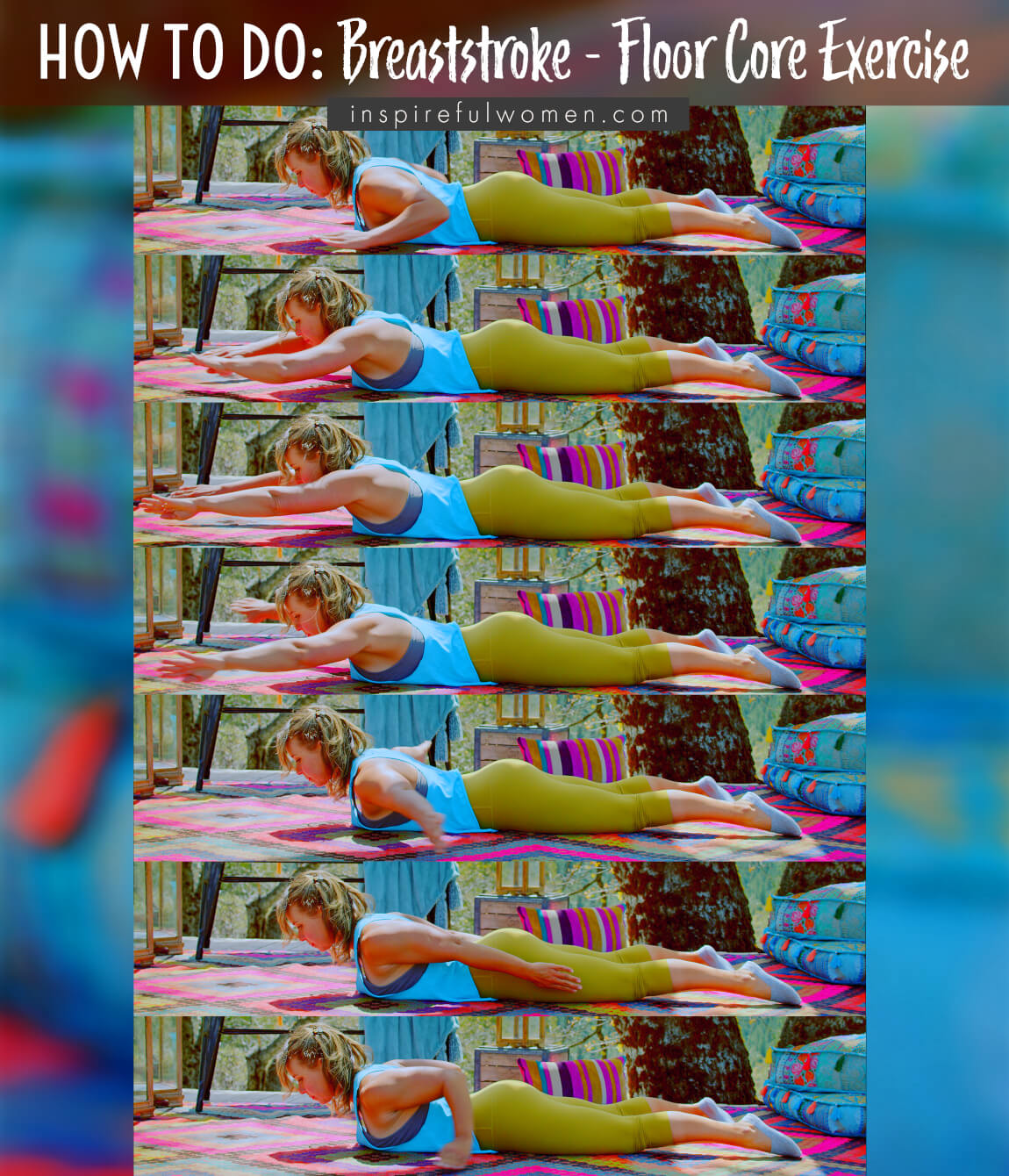
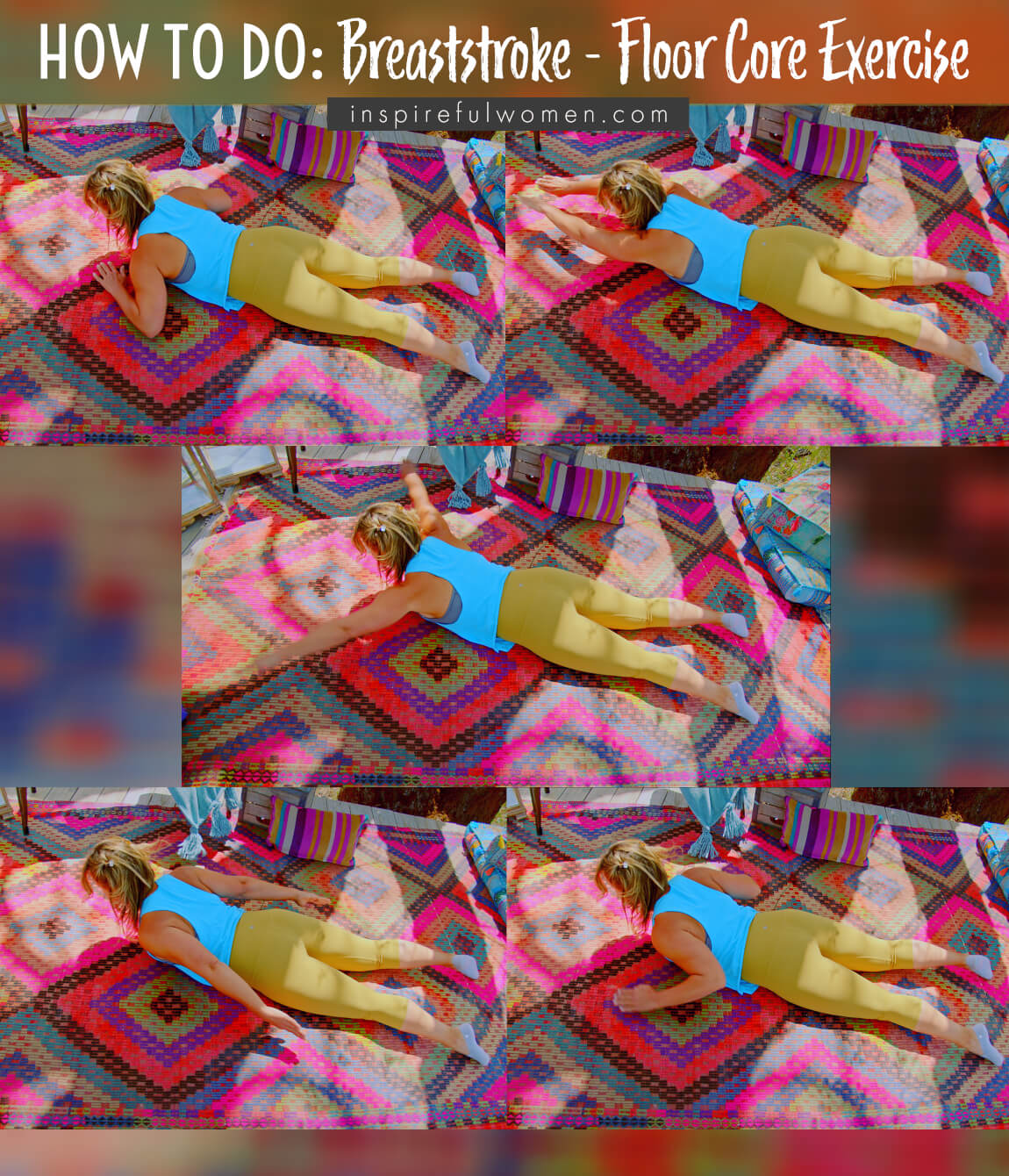
COMMON MISTAKES
COMMON MISTAKES
WHAT TO AVOID WITH THE Breaststroke - Ab & Back Exercise
KEY TIP:
Guess what? Good news! Many avoids are the same for most movements. Once you learn the basics, there's really only a few extra avoids for each individual movement.
1. Avoid Lifting Neck
AVOID: Lifting the neck.
WHY NOT?
- Repetitive lifting or holding the neck in an extended position (chin tilted up) can irritate the small neck joints, and strain the muscles.
- You may feel pressure or discomfort in your neck if you are lifting back.
WHAT TO DO:
- Keep the neck in line with the rest of the spine - you will be facing the floor.
- Think of lengthening the neck, as if someone were gently pulling your head away from the rest of the body.
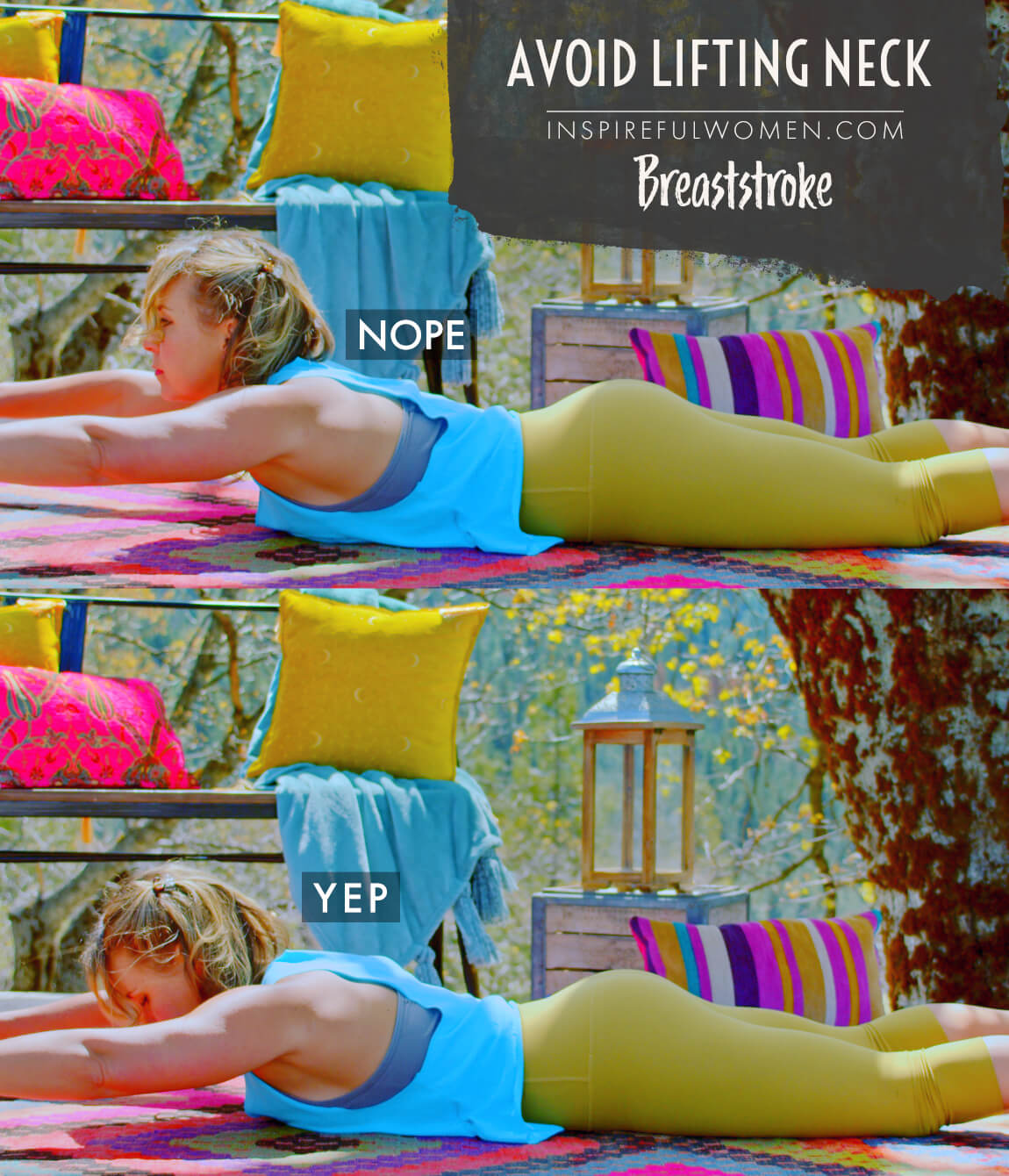
2. Avoid Lifting Too High
AVOID: Lifting up too high.
WHY NOT?
- This can strain the back muscles and joints.
- Lifting too high will increase the lumbar (low back) extension (back bend), which can irritate the discs, joints, and nerves of the spine, and can strain the muscles.
- This can be either immediate or it can cause undetected damage that will accumulate over time.
WHAT TO DO:
- Only the top of the torso should lift up - the shoulders and the top of the ribcage.
- The upper body should just barely hover over the floor.
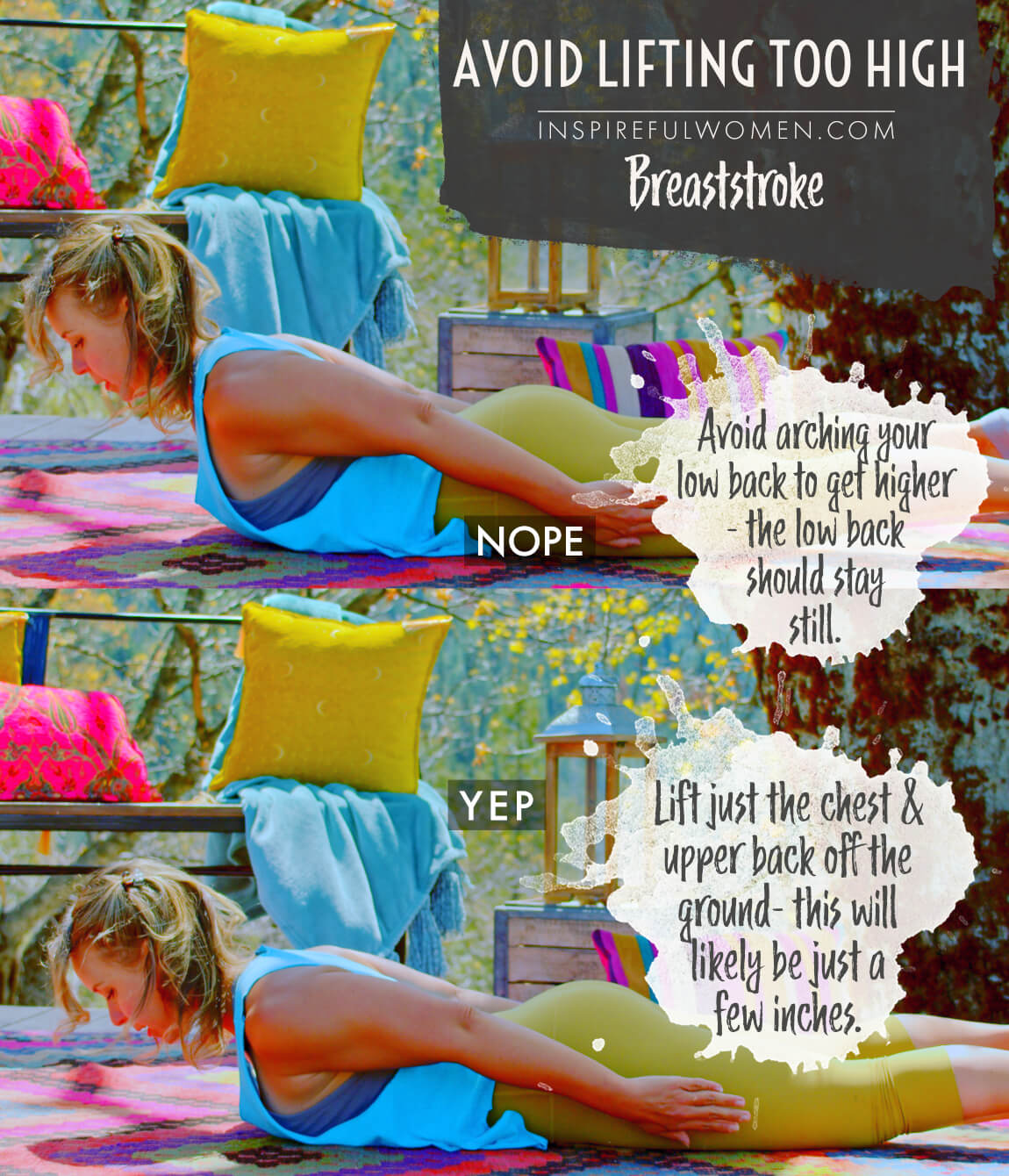
3. Avoid Arching Low Back
AVOID: Arching the low back.
WHY NOT?
- An increase in the lumbar (low back) extension (back bend can irritate the discs, joints, and nerves of the spine, and can strain the muscles.
- This can be either immediate or it can cause undetected damage that will accumulate over time.
- If you are arching your back you may feel discomfort or pressure in your low back.
WHAT TO DO:
- Keep pubic bone pressed to the floor
- Keep the belly button pulled up towards the spine to activate the abdominal muscles and keep the low back in neutral.
- Try putting a folded towel under your ankles to bend the knees.
4. Avoid Hunching Shoulders
AVOID: Hunching the shoulders up towards the ears.
WHY NOT?
- This means that you are activating the upper trap muscles.
- When the upper traps contract and shorten, they will pull the cervical vertebrae closer together.
- This exercise works the cervical stabilizers in a healthy neck position.
WHAT TO DO:
- Keep the neck lengthened.
- Keep the space between the ear and the shoulder during the entire rep to avoid tendon irritation and decrease the activity of the upper traps.

MAKE IT EASIER
EASIER
MAKE THE Breaststroke MORE DOABLE
Towel Under Shins
Towel Under Shins
This can help if you are having any pain in your low back during the exercise.
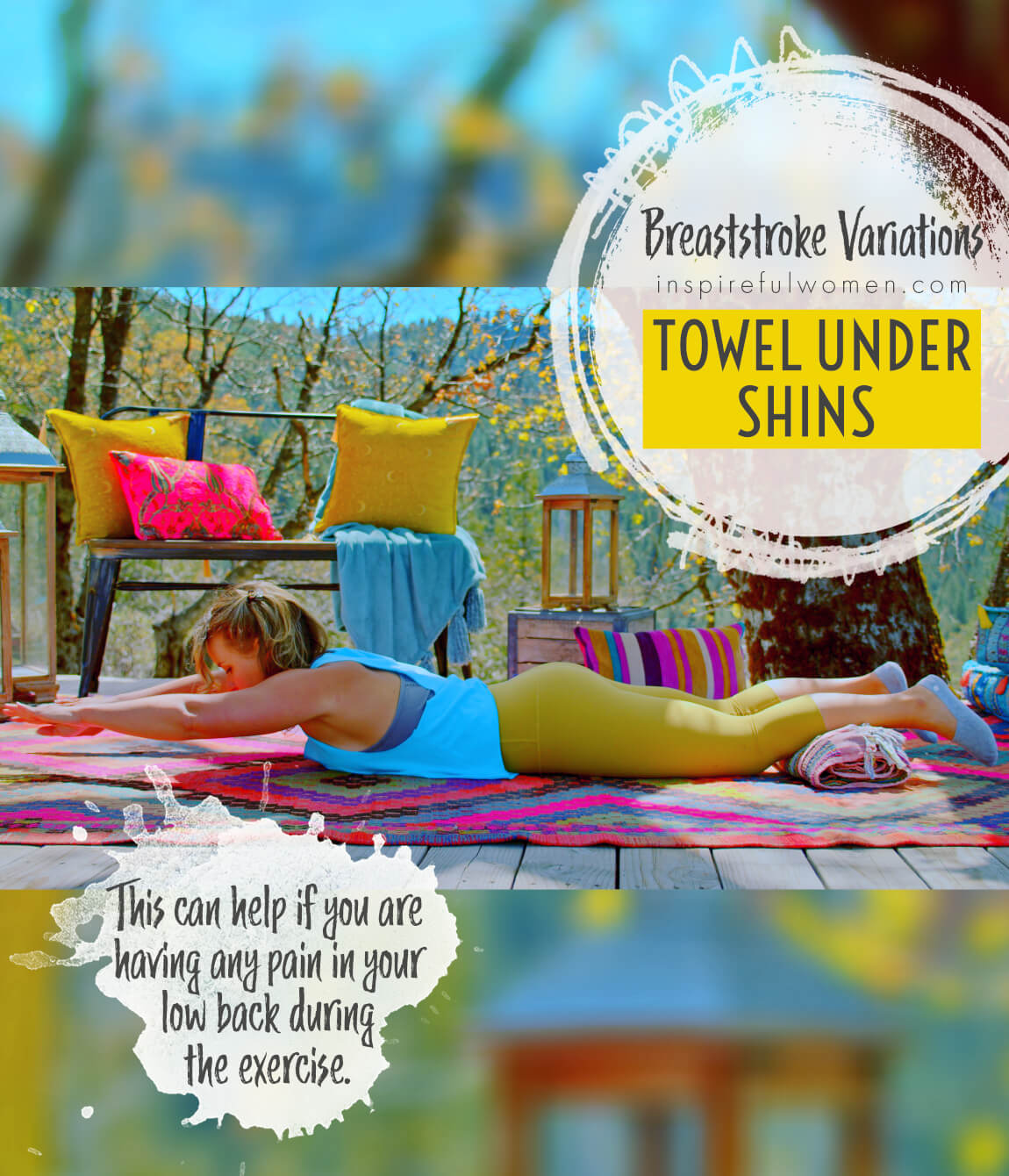
KEEP TORSO ON FLOOR
Keep torso on the floor
The spinal stabilizers will not be as active but you will still be working the muscles in the middle of the back that pulls the shoulder blades back when the arms lift up. A good way to progress the exercise is to try to lift for a few reps and then lower the upper body to the floor for the rest of the reps.
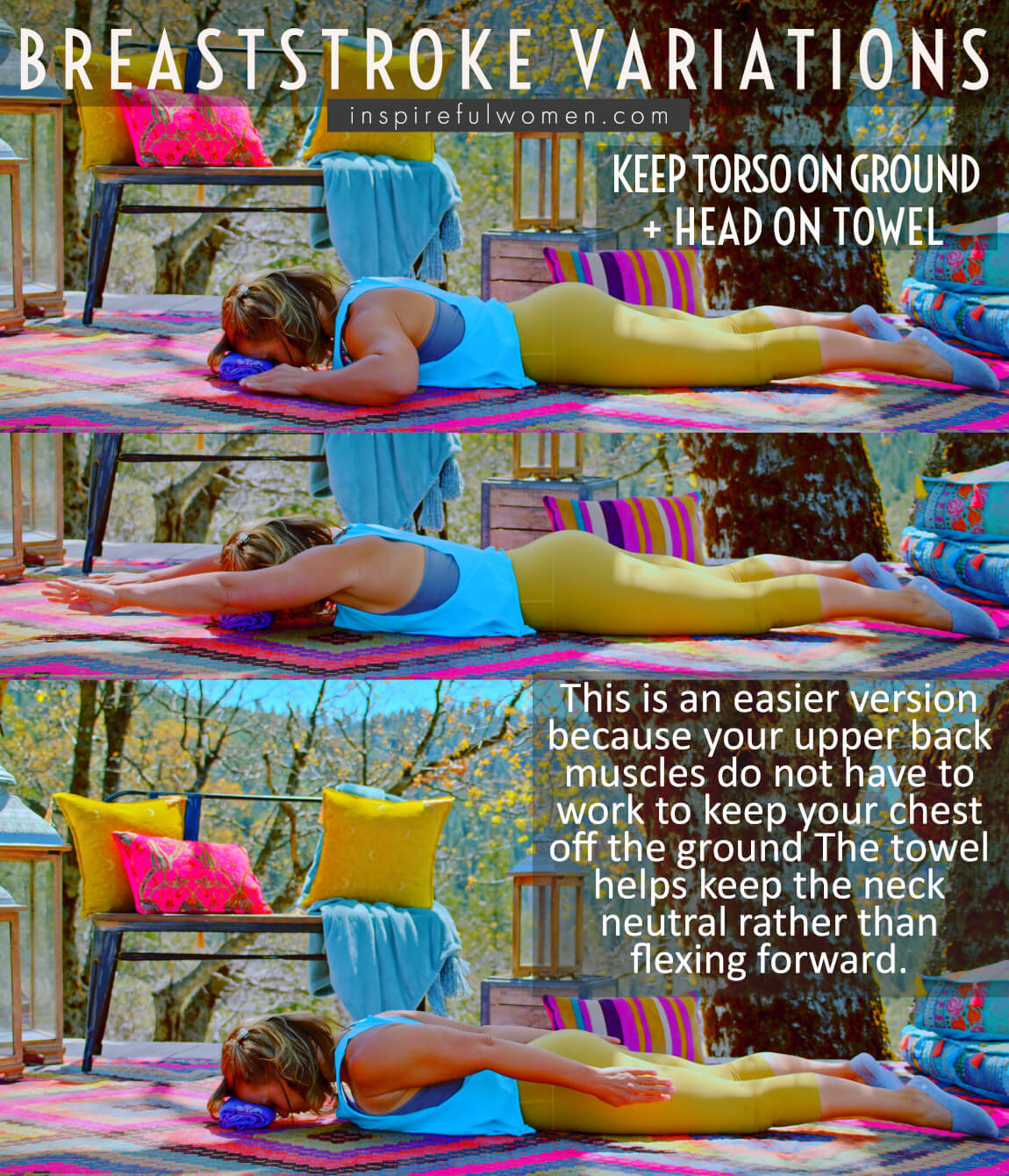
SCIENCY STUFF
SCIENCY STUFF
SPIFFILICIOUS FACTS ABOUT MUSCLES & MOVES
There is not a lot of motion in the thoracic spine. This is because the ribs attach to all of the thoracic vertebrae and ribs 1-7 attach directly to the sternum (cartilaginous attachment). [ribs 7 - 10 attach to the cartilage of the rib above, this is not a direct attachment to the sternum. The last two ribs, 11 and 12 are floating ribs, they do not attach to the sternum.] One of the main functions of the ribs is to form a protective cage around the heart and lungs.
Even though there is not a lot of movement in the thoracic spine, it does move, and so do the ribs. The ribs are springy - to absorb impact. They move in, out, up, and down, and they can rotate. The ribs move with the movement of the arms, and with breathing. When ribs get “sticky” or tight, they will affect the movement of the shoulder blade and therefore, the arm. Ribs can become immobile as a result of thoracic spine hypomobility - or tightness.
The thoracic spine has a natural curve. The curve is in the opposite direction of the curve of the neck and low back. The curves of the neck and low back are called lordosis - they curve inward towards the inside of the body. The thoracic spine curves out, away from the inside of the body, this is called kyphosis. A sign of osteoporosis is an increase in kyphosis, or a rounding forward of the spine. This is due to changes in the shape of the vertebrae as a result of compression fractures.
ALLLL MUSCLES & WHEN
ALL MUSCLES WORKING & WHEN DURING THE Breaststroke Core Exercise
The transverse abdominis, rectus abdominis, obliques, erector spinae, and quadratus lumborum stabilize the spine in neutral. The gluteus maximus may help to hold the pelvis in neutral (against gravity pulling the top of the pelvis forward into an anterior tilt).
Holding the cervical spine in neutral - longus colli, longus capitis, rectus capitis, and longus cervicis. As the upper body is lifted up to hover: the thoracic portions of the erector spinae (iliocostalis, longissimus, and spinals) work to hold the upper back in alignment against gravity.
The scapular retractor (rhomboids and mid traps), rear deltoid, lats, teres major, and triceps will hold the arms up off of the floor as they circle around. The anterior deltoid and biceps move the arms up overhead, there is very little demand on these muscles because there is no added resistance, just overcoming the inertia from the weight of the arm. The serratus anterior and upper and lower trapezius rotate the shoulder blade upward with the arm.
The latissimus dorsi and teres major pull the arm back down to the sides. The latissimus dorsi, levator, and pectoralis muscles will rotate the shoulder blade down as the arm comes down.
PIN IT FOR LATER!
